Human-Machine Interaction: Guidelines and Standards Comparison
VerifiedAdded on 2020/05/04
|9
|1948
|61
Report
AI Summary
This report provides a comprehensive comparative analysis of international guidelines and standards that govern Human-Machine Interactions (HMI). The study begins with an introduction to HCI, its working with ISO ergonomics, and the significance of user interface and software engineering standards. It explores the "top-down" approach, focusing on usability, and delves into literature reviews on the topic. The analysis covers the importance of input devices, the role of international guidelines, and the evolution of standards like ISO/IEC JTC1. The report also examines the application of these standards in real-world scenarios, including robotics and interactive displays in cars. The conclusion highlights the significance of ISO standards for ease of operation and the ongoing development of international standards to meet market needs. The report also includes a list of references used for the study.
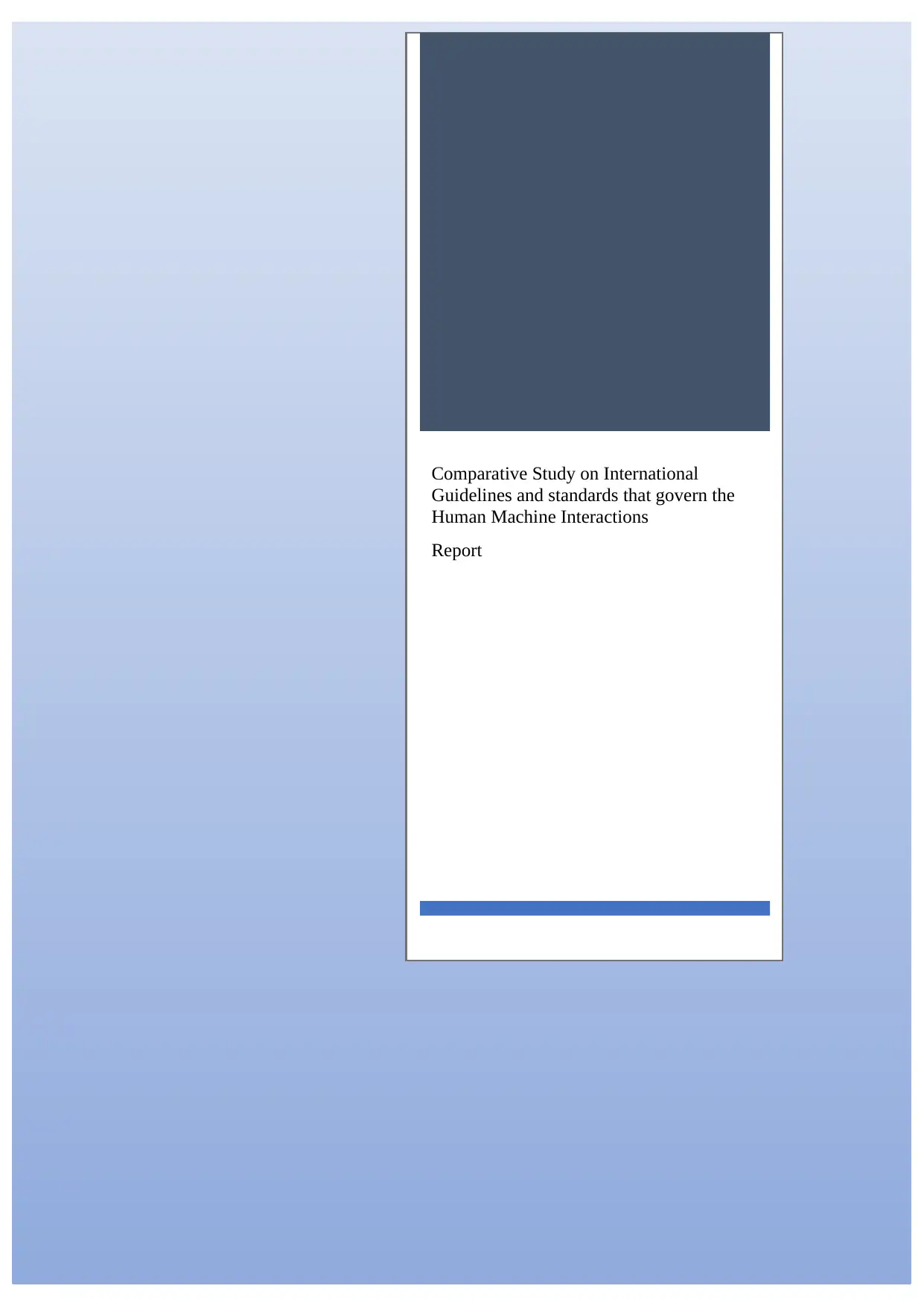
Comparative Study on International
Guidelines and standards that govern the
Human Machine Interactions
Report
Guidelines and standards that govern the
Human Machine Interactions
Report
Paraphrase This Document
Need a fresh take? Get an instant paraphrase of this document with our AI Paraphraser


Summary
There are different approaches which are important for the designing guides with detailed
specifications of the user interface. The consistency and the appropriate users and tasks help
in evaluating for producing an interface to meet the user and the task needs. The “top down”
approach is concerned mainly with the usability where the ability is to use the product with
the intended purpose.
There are different approaches which are important for the designing guides with detailed
specifications of the user interface. The consistency and the appropriate users and tasks help
in evaluating for producing an interface to meet the user and the task needs. The “top down”
approach is concerned mainly with the usability where the ability is to use the product with
the intended purpose.
⊘ This is a preview!⊘
Do you want full access?
Subscribe today to unlock all pages.

Trusted by 1+ million students worldwide
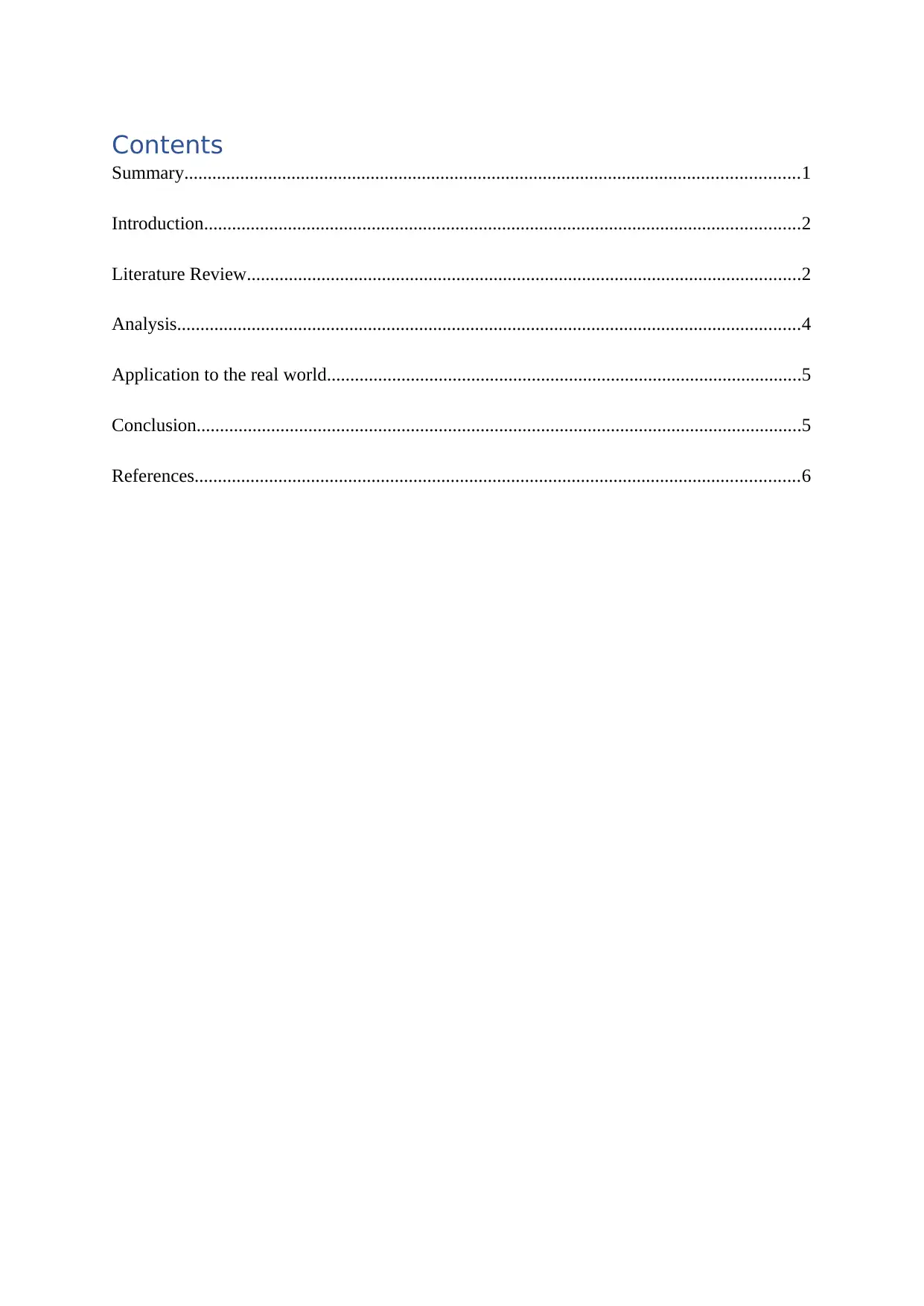
Contents
Summary....................................................................................................................................1
Introduction................................................................................................................................2
Literature Review.......................................................................................................................2
Analysis......................................................................................................................................4
Application to the real world......................................................................................................5
Conclusion..................................................................................................................................5
References..................................................................................................................................6
Summary....................................................................................................................................1
Introduction................................................................................................................................2
Literature Review.......................................................................................................................2
Analysis......................................................................................................................................4
Application to the real world......................................................................................................5
Conclusion..................................................................................................................................5
References..................................................................................................................................6
Paraphrase This Document
Need a fresh take? Get an instant paraphrase of this document with our AI Paraphraser
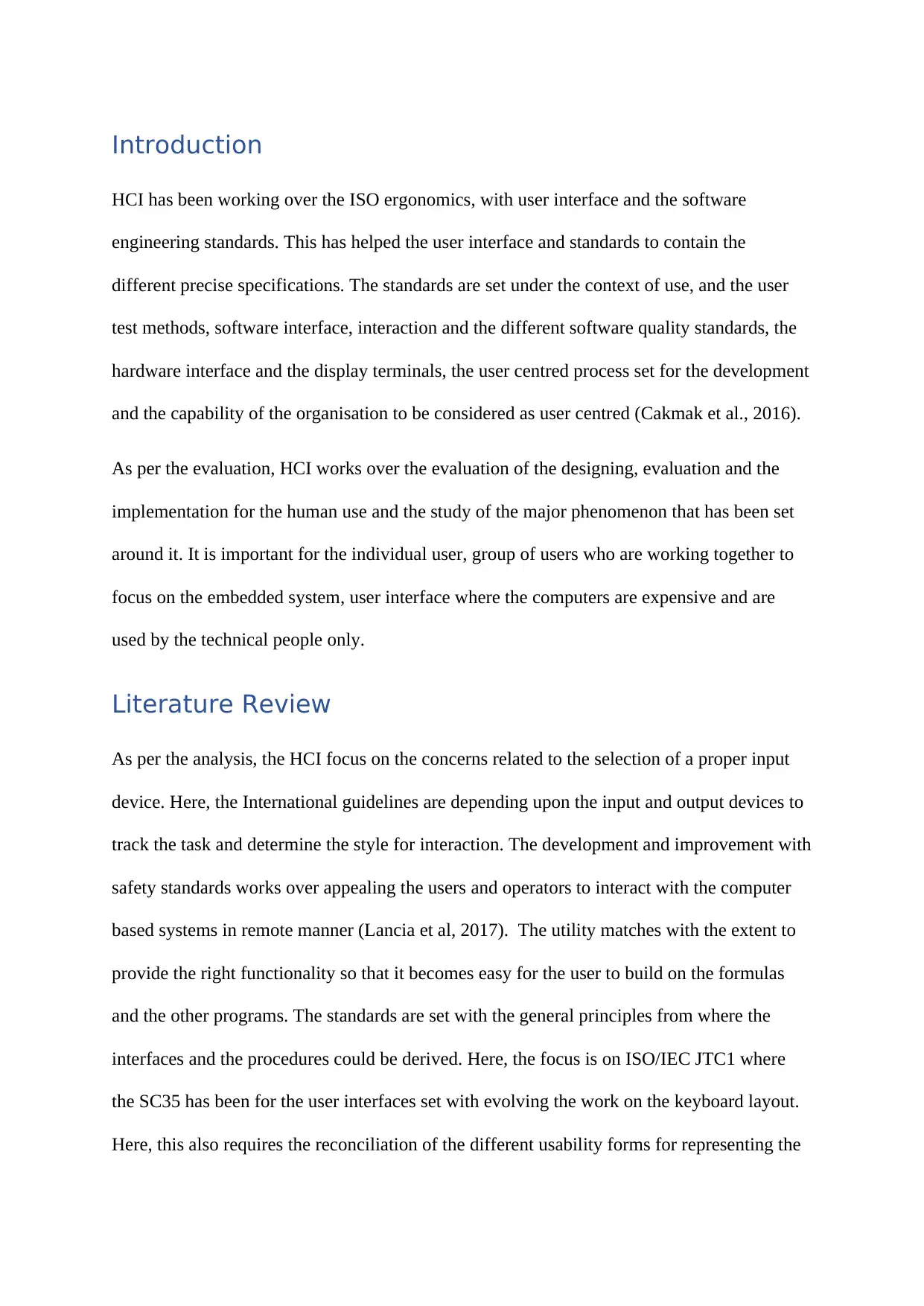
Introduction
HCI has been working over the ISO ergonomics, with user interface and the software
engineering standards. This has helped the user interface and standards to contain the
different precise specifications. The standards are set under the context of use, and the user
test methods, software interface, interaction and the different software quality standards, the
hardware interface and the display terminals, the user centred process set for the development
and the capability of the organisation to be considered as user centred (Cakmak et al., 2016).
As per the evaluation, HCI works over the evaluation of the designing, evaluation and the
implementation for the human use and the study of the major phenomenon that has been set
around it. It is important for the individual user, group of users who are working together to
focus on the embedded system, user interface where the computers are expensive and are
used by the technical people only.
Literature Review
As per the analysis, the HCI focus on the concerns related to the selection of a proper input
device. Here, the International guidelines are depending upon the input and output devices to
track the task and determine the style for interaction. The development and improvement with
safety standards works over appealing the users and operators to interact with the computer
based systems in remote manner (Lancia et al, 2017). The utility matches with the extent to
provide the right functionality so that it becomes easy for the user to build on the formulas
and the other programs. The standards are set with the general principles from where the
interfaces and the procedures could be derived. Here, the focus is on ISO/IEC JTC1 where
the SC35 has been for the user interfaces set with evolving the work on the keyboard layout.
Here, this also requires the reconciliation of the different usability forms for representing the
HCI has been working over the ISO ergonomics, with user interface and the software
engineering standards. This has helped the user interface and standards to contain the
different precise specifications. The standards are set under the context of use, and the user
test methods, software interface, interaction and the different software quality standards, the
hardware interface and the display terminals, the user centred process set for the development
and the capability of the organisation to be considered as user centred (Cakmak et al., 2016).
As per the evaluation, HCI works over the evaluation of the designing, evaluation and the
implementation for the human use and the study of the major phenomenon that has been set
around it. It is important for the individual user, group of users who are working together to
focus on the embedded system, user interface where the computers are expensive and are
used by the technical people only.
Literature Review
As per the analysis, the HCI focus on the concerns related to the selection of a proper input
device. Here, the International guidelines are depending upon the input and output devices to
track the task and determine the style for interaction. The development and improvement with
safety standards works over appealing the users and operators to interact with the computer
based systems in remote manner (Lancia et al, 2017). The utility matches with the extent to
provide the right functionality so that it becomes easy for the user to build on the formulas
and the other programs. The standards are set with the general principles from where the
interfaces and the procedures could be derived. Here, the focus is on ISO/IEC JTC1 where
the SC35 has been for the user interfaces set with evolving the work on the keyboard layout.
Here, this also requires the reconciliation of the different usability forms for representing the
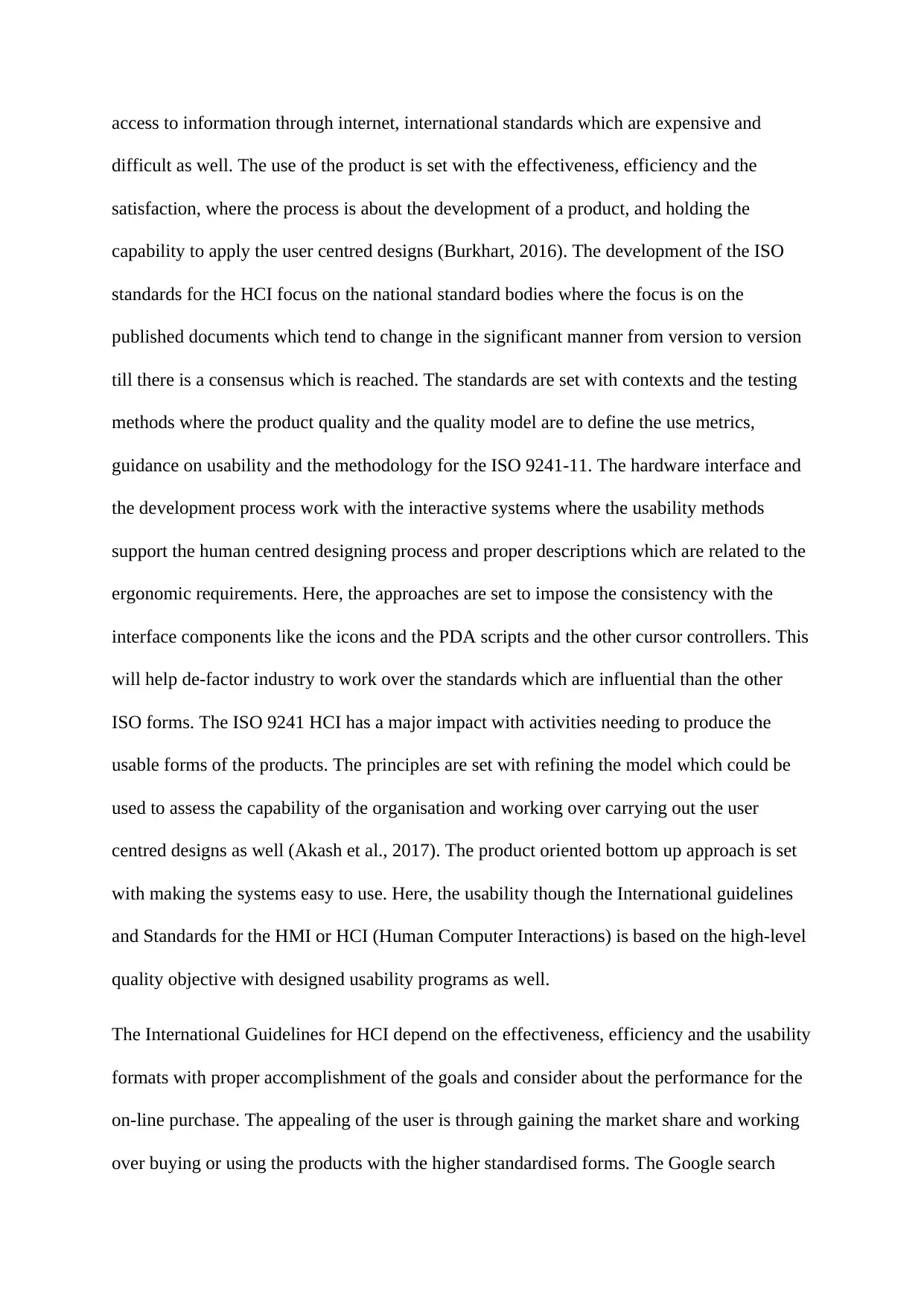
access to information through internet, international standards which are expensive and
difficult as well. The use of the product is set with the effectiveness, efficiency and the
satisfaction, where the process is about the development of a product, and holding the
capability to apply the user centred designs (Burkhart, 2016). The development of the ISO
standards for the HCI focus on the national standard bodies where the focus is on the
published documents which tend to change in the significant manner from version to version
till there is a consensus which is reached. The standards are set with contexts and the testing
methods where the product quality and the quality model are to define the use metrics,
guidance on usability and the methodology for the ISO 9241-11. The hardware interface and
the development process work with the interactive systems where the usability methods
support the human centred designing process and proper descriptions which are related to the
ergonomic requirements. Here, the approaches are set to impose the consistency with the
interface components like the icons and the PDA scripts and the other cursor controllers. This
will help de-factor industry to work over the standards which are influential than the other
ISO forms. The ISO 9241 HCI has a major impact with activities needing to produce the
usable forms of the products. The principles are set with refining the model which could be
used to assess the capability of the organisation and working over carrying out the user
centred designs as well (Akash et al., 2017). The product oriented bottom up approach is set
with making the systems easy to use. Here, the usability though the International guidelines
and Standards for the HMI or HCI (Human Computer Interactions) is based on the high-level
quality objective with designed usability programs as well.
The International Guidelines for HCI depend on the effectiveness, efficiency and the usability
formats with proper accomplishment of the goals and consider about the performance for the
on-line purchase. The appealing of the user is through gaining the market share and working
over buying or using the products with the higher standardised forms. The Google search
difficult as well. The use of the product is set with the effectiveness, efficiency and the
satisfaction, where the process is about the development of a product, and holding the
capability to apply the user centred designs (Burkhart, 2016). The development of the ISO
standards for the HCI focus on the national standard bodies where the focus is on the
published documents which tend to change in the significant manner from version to version
till there is a consensus which is reached. The standards are set with contexts and the testing
methods where the product quality and the quality model are to define the use metrics,
guidance on usability and the methodology for the ISO 9241-11. The hardware interface and
the development process work with the interactive systems where the usability methods
support the human centred designing process and proper descriptions which are related to the
ergonomic requirements. Here, the approaches are set to impose the consistency with the
interface components like the icons and the PDA scripts and the other cursor controllers. This
will help de-factor industry to work over the standards which are influential than the other
ISO forms. The ISO 9241 HCI has a major impact with activities needing to produce the
usable forms of the products. The principles are set with refining the model which could be
used to assess the capability of the organisation and working over carrying out the user
centred designs as well (Akash et al., 2017). The product oriented bottom up approach is set
with making the systems easy to use. Here, the usability though the International guidelines
and Standards for the HMI or HCI (Human Computer Interactions) is based on the high-level
quality objective with designed usability programs as well.
The International Guidelines for HCI depend on the effectiveness, efficiency and the usability
formats with proper accomplishment of the goals and consider about the performance for the
on-line purchase. The appealing of the user is through gaining the market share and working
over buying or using the products with the higher standardised forms. The Google search
⊘ This is a preview!⊘
Do you want full access?
Subscribe today to unlock all pages.

Trusted by 1+ million students worldwide
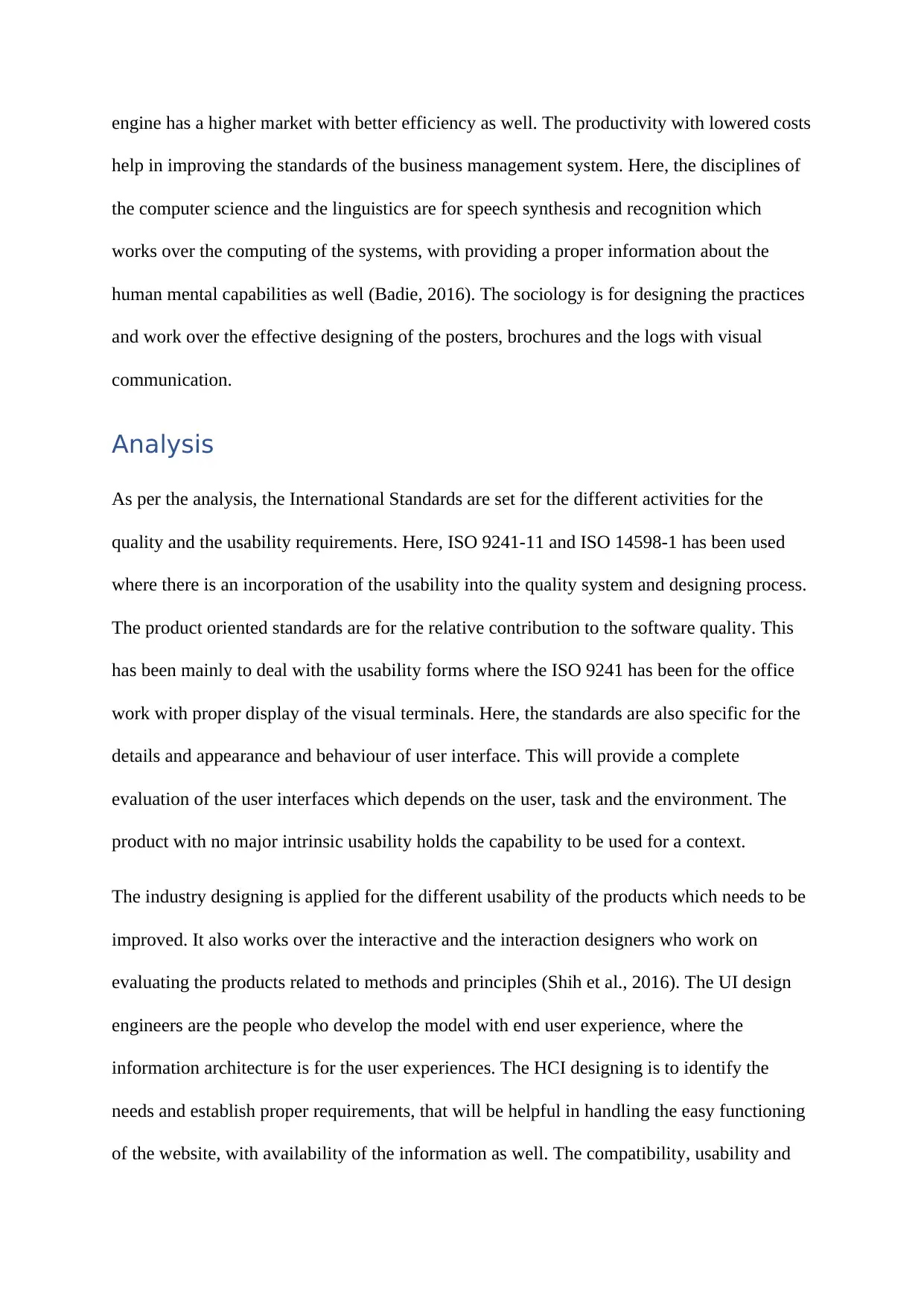
engine has a higher market with better efficiency as well. The productivity with lowered costs
help in improving the standards of the business management system. Here, the disciplines of
the computer science and the linguistics are for speech synthesis and recognition which
works over the computing of the systems, with providing a proper information about the
human mental capabilities as well (Badie, 2016). The sociology is for designing the practices
and work over the effective designing of the posters, brochures and the logs with visual
communication.
Analysis
As per the analysis, the International Standards are set for the different activities for the
quality and the usability requirements. Here, ISO 9241-11 and ISO 14598-1 has been used
where there is an incorporation of the usability into the quality system and designing process.
The product oriented standards are for the relative contribution to the software quality. This
has been mainly to deal with the usability forms where the ISO 9241 has been for the office
work with proper display of the visual terminals. Here, the standards are also specific for the
details and appearance and behaviour of user interface. This will provide a complete
evaluation of the user interfaces which depends on the user, task and the environment. The
product with no major intrinsic usability holds the capability to be used for a context.
The industry designing is applied for the different usability of the products which needs to be
improved. It also works over the interactive and the interaction designers who work on
evaluating the products related to methods and principles (Shih et al., 2016). The UI design
engineers are the people who develop the model with end user experience, where the
information architecture is for the user experiences. The HCI designing is to identify the
needs and establish proper requirements, that will be helpful in handling the easy functioning
of the website, with availability of the information as well. The compatibility, usability and
help in improving the standards of the business management system. Here, the disciplines of
the computer science and the linguistics are for speech synthesis and recognition which
works over the computing of the systems, with providing a proper information about the
human mental capabilities as well (Badie, 2016). The sociology is for designing the practices
and work over the effective designing of the posters, brochures and the logs with visual
communication.
Analysis
As per the analysis, the International Standards are set for the different activities for the
quality and the usability requirements. Here, ISO 9241-11 and ISO 14598-1 has been used
where there is an incorporation of the usability into the quality system and designing process.
The product oriented standards are for the relative contribution to the software quality. This
has been mainly to deal with the usability forms where the ISO 9241 has been for the office
work with proper display of the visual terminals. Here, the standards are also specific for the
details and appearance and behaviour of user interface. This will provide a complete
evaluation of the user interfaces which depends on the user, task and the environment. The
product with no major intrinsic usability holds the capability to be used for a context.
The industry designing is applied for the different usability of the products which needs to be
improved. It also works over the interactive and the interaction designers who work on
evaluating the products related to methods and principles (Shih et al., 2016). The UI design
engineers are the people who develop the model with end user experience, where the
information architecture is for the user experiences. The HCI designing is to identify the
needs and establish proper requirements, that will be helpful in handling the easy functioning
of the website, with availability of the information as well. The compatibility, usability and
Paraphrase This Document
Need a fresh take? Get an instant paraphrase of this document with our AI Paraphraser
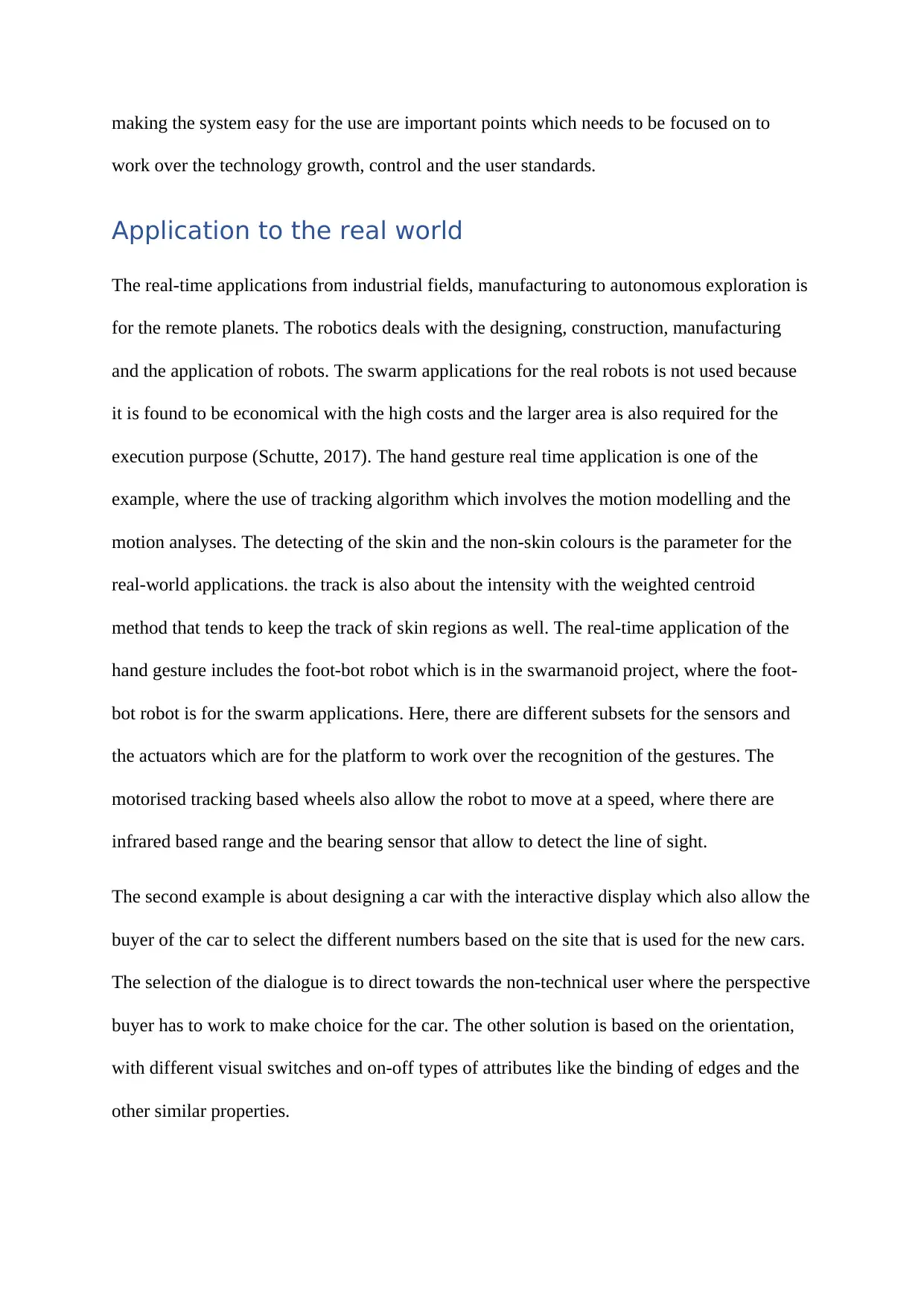
making the system easy for the use are important points which needs to be focused on to
work over the technology growth, control and the user standards.
Application to the real world
The real-time applications from industrial fields, manufacturing to autonomous exploration is
for the remote planets. The robotics deals with the designing, construction, manufacturing
and the application of robots. The swarm applications for the real robots is not used because
it is found to be economical with the high costs and the larger area is also required for the
execution purpose (Schutte, 2017). The hand gesture real time application is one of the
example, where the use of tracking algorithm which involves the motion modelling and the
motion analyses. The detecting of the skin and the non-skin colours is the parameter for the
real-world applications. the track is also about the intensity with the weighted centroid
method that tends to keep the track of skin regions as well. The real-time application of the
hand gesture includes the foot-bot robot which is in the swarmanoid project, where the foot-
bot robot is for the swarm applications. Here, there are different subsets for the sensors and
the actuators which are for the platform to work over the recognition of the gestures. The
motorised tracking based wheels also allow the robot to move at a speed, where there are
infrared based range and the bearing sensor that allow to detect the line of sight.
The second example is about designing a car with the interactive display which also allow the
buyer of the car to select the different numbers based on the site that is used for the new cars.
The selection of the dialogue is to direct towards the non-technical user where the perspective
buyer has to work to make choice for the car. The other solution is based on the orientation,
with different visual switches and on-off types of attributes like the binding of edges and the
other similar properties.
work over the technology growth, control and the user standards.
Application to the real world
The real-time applications from industrial fields, manufacturing to autonomous exploration is
for the remote planets. The robotics deals with the designing, construction, manufacturing
and the application of robots. The swarm applications for the real robots is not used because
it is found to be economical with the high costs and the larger area is also required for the
execution purpose (Schutte, 2017). The hand gesture real time application is one of the
example, where the use of tracking algorithm which involves the motion modelling and the
motion analyses. The detecting of the skin and the non-skin colours is the parameter for the
real-world applications. the track is also about the intensity with the weighted centroid
method that tends to keep the track of skin regions as well. The real-time application of the
hand gesture includes the foot-bot robot which is in the swarmanoid project, where the foot-
bot robot is for the swarm applications. Here, there are different subsets for the sensors and
the actuators which are for the platform to work over the recognition of the gestures. The
motorised tracking based wheels also allow the robot to move at a speed, where there are
infrared based range and the bearing sensor that allow to detect the line of sight.
The second example is about designing a car with the interactive display which also allow the
buyer of the car to select the different numbers based on the site that is used for the new cars.
The selection of the dialogue is to direct towards the non-technical user where the perspective
buyer has to work to make choice for the car. The other solution is based on the orientation,
with different visual switches and on-off types of attributes like the binding of edges and the
other similar properties.
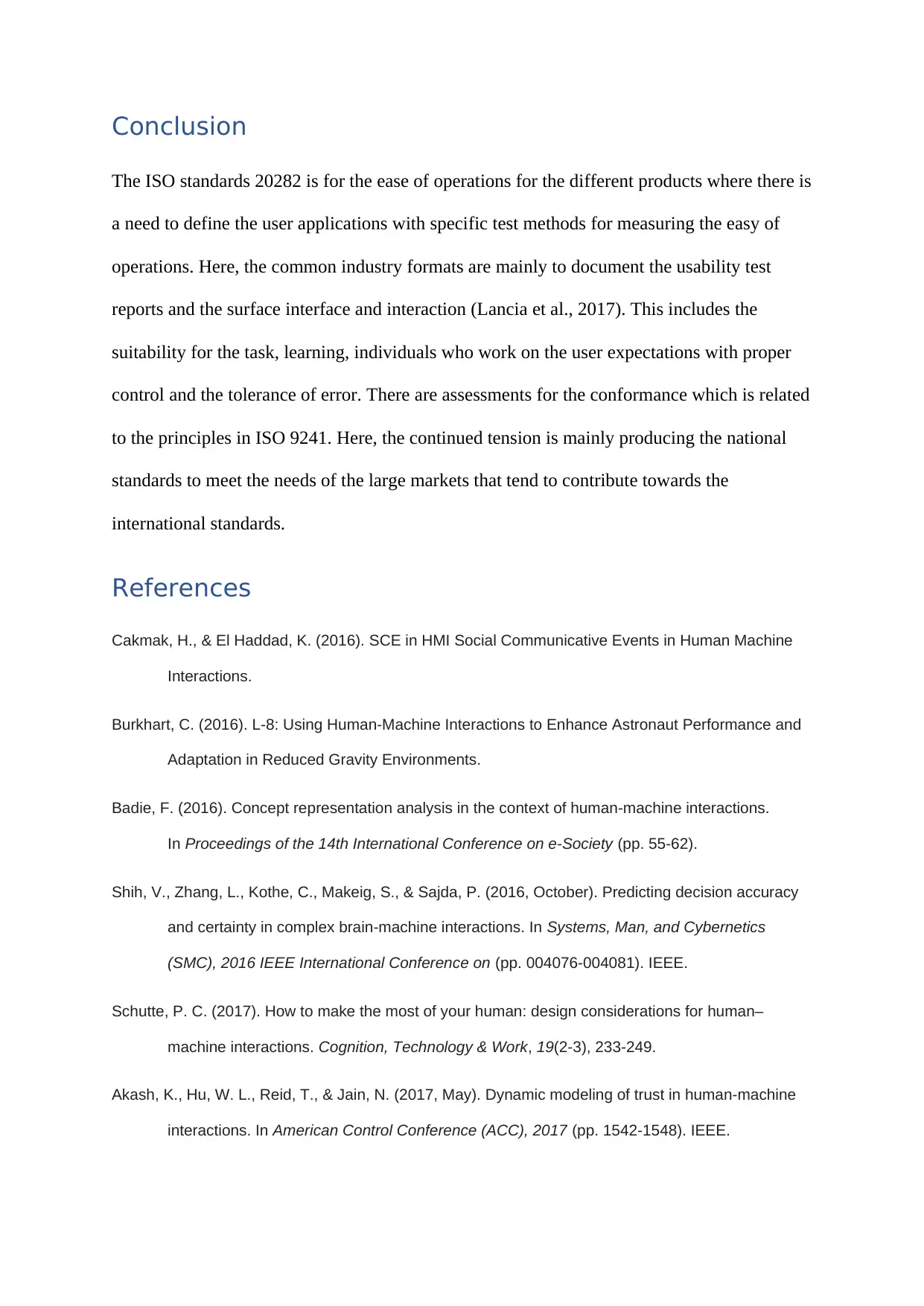
Conclusion
The ISO standards 20282 is for the ease of operations for the different products where there is
a need to define the user applications with specific test methods for measuring the easy of
operations. Here, the common industry formats are mainly to document the usability test
reports and the surface interface and interaction (Lancia et al., 2017). This includes the
suitability for the task, learning, individuals who work on the user expectations with proper
control and the tolerance of error. There are assessments for the conformance which is related
to the principles in ISO 9241. Here, the continued tension is mainly producing the national
standards to meet the needs of the large markets that tend to contribute towards the
international standards.
References
Cakmak, H., & El Haddad, K. (2016). SCE in HMI Social Communicative Events in Human Machine
Interactions.
Burkhart, C. (2016). L-8: Using Human-Machine Interactions to Enhance Astronaut Performance and
Adaptation in Reduced Gravity Environments.
Badie, F. (2016). Concept representation analysis in the context of human-machine interactions.
In Proceedings of the 14th International Conference on e-Society (pp. 55-62).
Shih, V., Zhang, L., Kothe, C., Makeig, S., & Sajda, P. (2016, October). Predicting decision accuracy
and certainty in complex brain-machine interactions. In Systems, Man, and Cybernetics
(SMC), 2016 IEEE International Conference on (pp. 004076-004081). IEEE.
Schutte, P. C. (2017). How to make the most of your human: design considerations for human–
machine interactions. Cognition, Technology & Work, 19(2-3), 233-249.
Akash, K., Hu, W. L., Reid, T., & Jain, N. (2017, May). Dynamic modeling of trust in human-machine
interactions. In American Control Conference (ACC), 2017 (pp. 1542-1548). IEEE.
The ISO standards 20282 is for the ease of operations for the different products where there is
a need to define the user applications with specific test methods for measuring the easy of
operations. Here, the common industry formats are mainly to document the usability test
reports and the surface interface and interaction (Lancia et al., 2017). This includes the
suitability for the task, learning, individuals who work on the user expectations with proper
control and the tolerance of error. There are assessments for the conformance which is related
to the principles in ISO 9241. Here, the continued tension is mainly producing the national
standards to meet the needs of the large markets that tend to contribute towards the
international standards.
References
Cakmak, H., & El Haddad, K. (2016). SCE in HMI Social Communicative Events in Human Machine
Interactions.
Burkhart, C. (2016). L-8: Using Human-Machine Interactions to Enhance Astronaut Performance and
Adaptation in Reduced Gravity Environments.
Badie, F. (2016). Concept representation analysis in the context of human-machine interactions.
In Proceedings of the 14th International Conference on e-Society (pp. 55-62).
Shih, V., Zhang, L., Kothe, C., Makeig, S., & Sajda, P. (2016, October). Predicting decision accuracy
and certainty in complex brain-machine interactions. In Systems, Man, and Cybernetics
(SMC), 2016 IEEE International Conference on (pp. 004076-004081). IEEE.
Schutte, P. C. (2017). How to make the most of your human: design considerations for human–
machine interactions. Cognition, Technology & Work, 19(2-3), 233-249.
Akash, K., Hu, W. L., Reid, T., & Jain, N. (2017, May). Dynamic modeling of trust in human-machine
interactions. In American Control Conference (ACC), 2017 (pp. 1542-1548). IEEE.
⊘ This is a preview!⊘
Do you want full access?
Subscribe today to unlock all pages.

Trusted by 1+ million students worldwide
1 out of 9
Related Documents
Your All-in-One AI-Powered Toolkit for Academic Success.
+13062052269
info@desklib.com
Available 24*7 on WhatsApp / Email
![[object Object]](/_next/static/media/star-bottom.7253800d.svg)
Unlock your academic potential
Copyright © 2020–2025 A2Z Services. All Rights Reserved. Developed and managed by ZUCOL.




